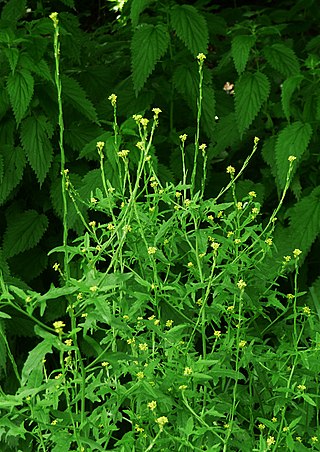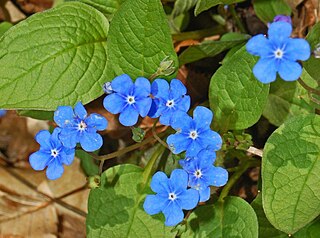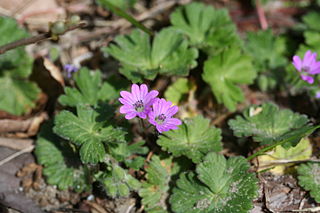
Mentha longifolia, also known as horse mint, brookmint, fillymint or St. John's horsemint, is a species of plant in the family Lamiaceae. It is native to Europe excluding Britain and Ireland, western and central Asia, and northern and southern Africa.

Leonurus cardiaca, known as motherwort, is an herbaceous perennial plant in the mint family, Lamiaceae. Other common names include throw-wort, lion's ear, and lion's tail. Lion's tail is also a common name for Leonotis leonurus, and lion's ear, a common name for Leonotis nepetifolia. Originally from Central Asia and southeastern Europe, it is now found worldwide, spread largely due to its use as a herbal remedy.

Pimpinella saxifraga, known as burnet-saxifrage, solidstem burnet saxifrage, lesser burnet is a plant species in the family Apiaceae, a native of the British Isles and temperate Europe and Western Asia. It is neither a burnet, which its leaves resemble, nor a saxifrage although it has a similar herbal effect as a diuretic.

Sisymbrium officinale, the hedge mustard, is a plant in the family Brassicaceae.

Pennywort is a common name given to several different plants around the world. In general they have round leaves and a low-growing habit. Pennywort may refer to:

Centella asiatica, commonly known as Indian pennywort and Asiatic pennywort, is a herbaceous, perennial plant in the flowering plant family Apiaceae. It is native to tropical regions of Africa, Asia, Australia, and islands in the western Pacific Ocean. It is consumed as a culinary vegetable and is used in traditional medicine.

Hierochloe odorata or Anthoxanthum nitens is an aromatic herb native to northern Eurasia and North America. It is considered sacred by many Indigenous peoples in Canada and the United States. It is used as a smudge in herbal medicine and in the production of distilled beverages. It owes its distinctive sweet scent to the presence of coumarin.

Omphalodes verna, the creeping navelwort or blue-eyed-Mary, is a rhizomatous herbaceous perennial plant in the genus Omphalodes belonging to the family Boraginaceae.

Sanicula europaea, the sanicle or wood sanicle, is a perennial plant of the family Apiaceae.

Betonica officinalis, commonly known as common hedgenettle, betony, purple betony, wood betony, bishopwort, or bishop's wort, is a species of flowering plant in the mint family Lamiaceae, native to Europe, western Asia, and northern Africa.

Geranium molle, the dove's-foot crane's-bill or dovesfoot geranium, is an annual herbaceous plant of the family Geraniaceae.

Umbilicus intermedius, the intermediate navelwort or common pennywort, is a succulent, perennial flowering plant in the stonecrop family Crassulaceae found in the shrublands and deserts of Israel and Lebanon.

Hydrocotyle vulgaris, the marsh pennywort, common pennywort, water naval, money plant, lucky plant or copper coin, is a small creeping aquatic perennial plant native to North Africa, Europe, the Caucasus and parts of the Levant.

Hypericum maculatum, commonly known as imperforate St John's-wort, or spotted St. Johnswort, is a species of perennial herbaceous flowering plant in the family Hypericaceae. It is native to Europe and Western Asia where it grows in moist meadows.

Jasminum officinale, known as the common jasmine or simply jasmine, is a species of flowering plant in the olive family Oleaceae. It is native to the Caucasus and parts of Asia, also widely naturalized.

Lythrum portula is a species of flowering plant in the loosestrife family known by the common names water-purslane and spatulaleaf loosestrife. It is native to Europe, and it is found in parts of western North America as an introduced species. It often grows in moist habitat, such as marshes. This is a prostrate annual herb producing a hairless, reddish stem up to 25 centimeters long which lies along the ground and roots where its nodes come in contact with wet earth. The slightly fleshy, spoon-shaped leaves are about a centimeter long and greenish to reddish in color. Solitary flowers occur in leaf axils. Flowers often have white or pink petals about a millimeter long, but some lack petals. The fruit is a spherical capsule containing minute seeds.

Euphorbia hirta is a pantropical weed, originating from the tropical regions of the Americas. It is a hairy herb that grows in open grasslands, roadsides and pathways. It is widely used in traditional herbal medicine across many cultures, particularly for asthma, skin ailments, and hypertension. It is also consumed in herbal tea form as folk medicine for fevers in the Philippines, particularly for dengue fever and malaria.

Alchemilla arvensis, known as parsley-piert, is a sprawling, downy plant common all over the British Isles where It grows on arable fields and bare wastelands, particularly in dry sites. The short-stalked leaves have three segments each lobed at the tip. Flowers April–September. The tiny green flower has four sepals and no petals, the fruit is oval pointed. Stipules form a leaf-like cup, enclosing the flower. The name of parsley piert has nothing to do with parsley. It is a corruption of the French perce-pierre, meaning 'stone-piercer' and was given to the plant because of its habit of growing in shallow, stony soil and emerging between stones. As in the case of saxifrage it was wrongly assumed that the plant could pierce stones; and it was thought that a medicine made of parsley piert would break up stones in the bladder and kidneys. Old folk-names for the plant include 'colicwort' and 'bowel-hive-grass', showing that it was also used for intestinal ailments.
This is a list of plants documented to have been traditionally used by the Cherokee, and how they are used.




















